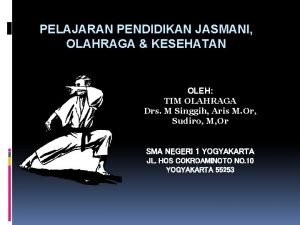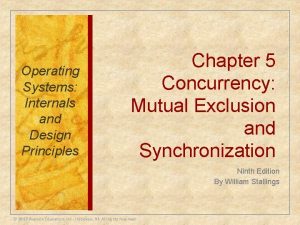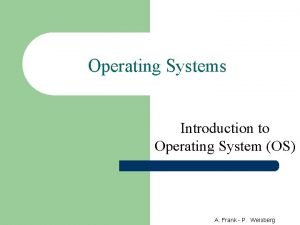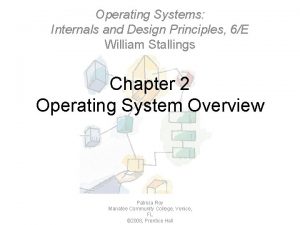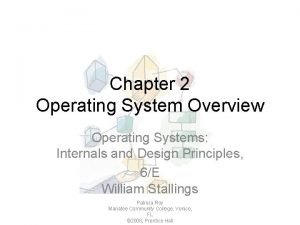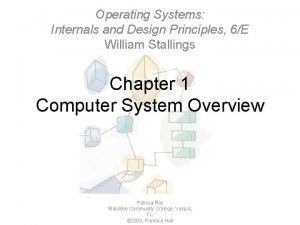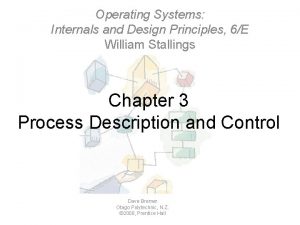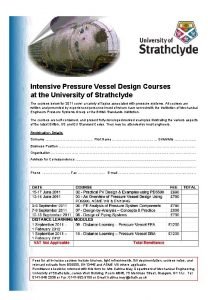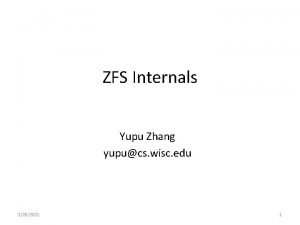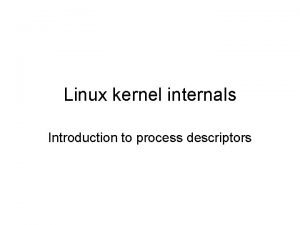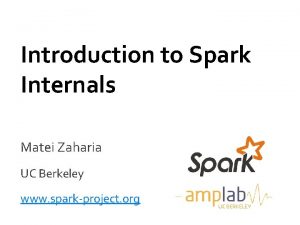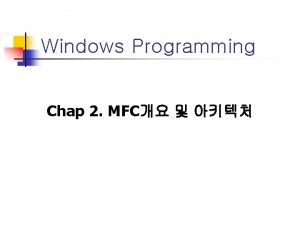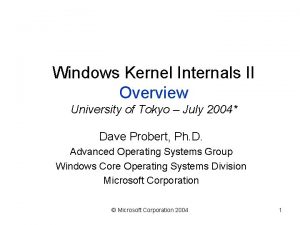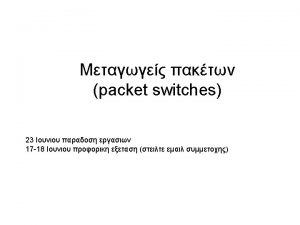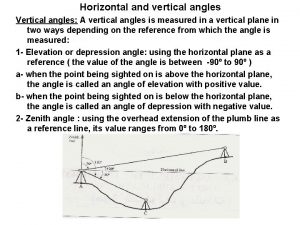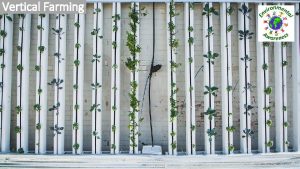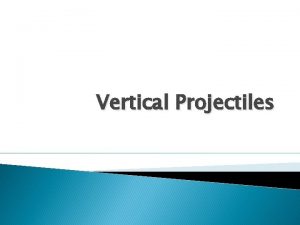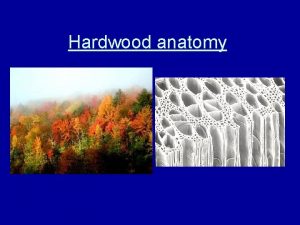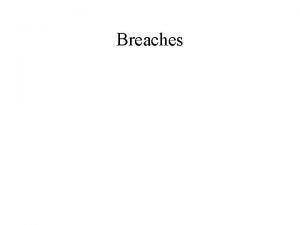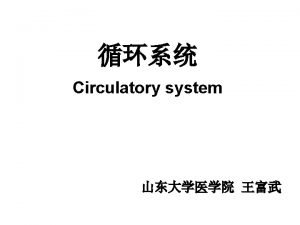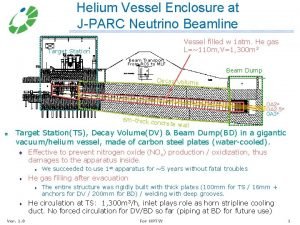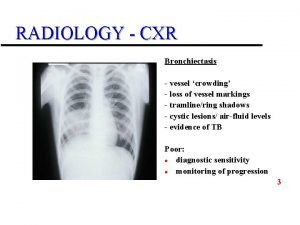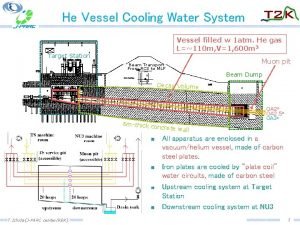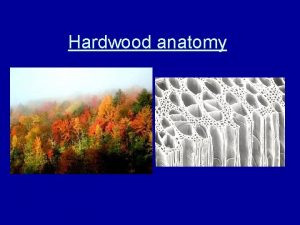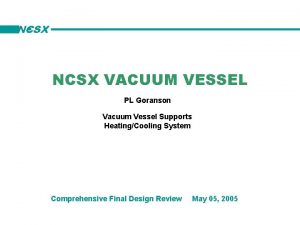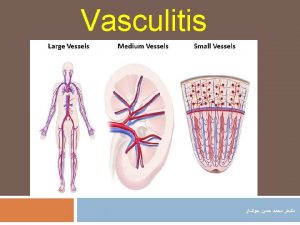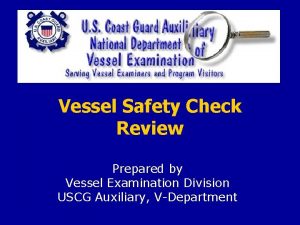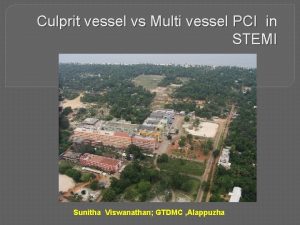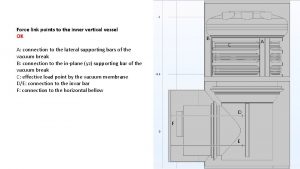Design Of Vertical KnockOut Vessel With No Internals





























- Slides: 29

Design Of Vertical Knock-Out Vessel With No Internals • Favorable Inlet 2 phase flow regime • Particle Dynamics – Separation of Liquid Droplets in Vapor Stream • Chem Eng Handbook, Perry VI Eq 5 -263, page 5 -66 • Liquid Retention Time • Pressure Vessel Economics

Types of Vertical KO Vessels • • Vertical – No Internals Vertical – With Demister Mesh Peerless - In-line or Vari-line Vanes Peerless Vane Type Line Separator FWG – Vertical Flow Chevron Vanes Cyclone With Tangential Inlet Entry Porta-Test Centripetal Flow Type

Types Of Horizontal KO Pots • • API-521 Horizontal With No Internals API-521 Horizontal With Mesh Pad Wu – Horizontal With Extended Inlet FWG – Horizontal Flow Chevron Type Porta-Test Recycling Separator Peerless Horizontal Gas Separator Kettle Refrigeration Exchanger

This Presentation Considers • Vertical KO Vessel With No Internals • Vertical KO With Mesh Pad

Problem Statement • Design a KO Pot to separate 49, 423 lb/hr of vapor from 382, 290 lb/hr of liquid. • Working Range liquid level holdup shall be +/- 2 minutes on normal liquid level. • Provide 2 minutes liquid holdup from high opg LL to Max LL. • Provide 2 minutes liquid holdup from low opg LL to Min. LL. • Total Liquid Retention time = 8 minutes.

First Design Consideration • As the liquid rate is high (382, 290 lb/hr), liquid volume will probably be the controlling design factor. • Consider using a Standard Vertical KO Pot with No Internals.


Problem Statement Cont’d • Vapor Destination – centrifugal compressor. • Liquid Destination – C 2 Splitter reflux. • Compressor Spec – To prevent damage to the compressor, the liquid droplet size in the inlet vapor stream shall not exceed a particle diameter, Dp, of 150 to 300 microns. • Design Spec – To achieve a goal of 150 microns, design the KO Pot for a particle diameter, Dp = 100 microns (or smaller).

Summary Of All Req’d Input

Step (1): Calc CFS Of Vapor • CFS = Vapor cubic feet per second. • CFS Vapor = Wv / 3600 / Dv. • CFS Vapor = 16. 29 cubic ft. per sec.

Step (2): Calc ( C )( Re^2 ) • • • CRe^2 from Perry VI - Eq 5 -263 CRe^2 = (A)( Constant) A = (Dp/304800)^3 (DL - Dv)(Dv) / c. P^2 Constant = (4*32. 2/3/0. 00067197^2) CRe^2 = 1, 411. 49 Where C = Drag Coefficient Re = Particle Reynolds Number

Step (3): Calc Drag Coefficient, C • Table 5 -22, Perry VI, Page 5 -67, gives C values versus CRe^2. These values have been curve fitted to a polynomial for the Re range 0. 1 to 2, 000 as follows: • C = EXP(6. 496 -1. 1478*LN(CRe^2) +0. 058065*LN(CRe^2)^2 0. 00097081*LN(CRe^2)^3) • C = 2. 35 for the example presented

Step (4): Calc Particle Reynolds Number, Re • Re = (CRe^2 / C)^0. 5 • Re = 24. 5 • Re falls within range 0. 1 < Re < 2, 000 OK to proceed to Step (5)

Step (5): Calc Drop Out Velocity • Drop Out velocity, ut, from Perry VI Eq 5 -264. • Ut = [Re / C*4*32. 2 *c. P* 0. 00067197 *(DL-Dv) / 3 / Dv^2]^0. 333333. • Ut = 0. 4659 ft. /sec.

Step (6): Calc Vessel Diameter • • • Area = (CFS / ut) = (3. 14 / 4 )(D)^2. KO Dia = (CFS / ut /0. 785)^0. 5. KO Dia = 6. 67 ft. Round Diameter to Nearest 3. ” Rounded Diameter = 7’ 0. ”

Step (7): Calc Ht. Above C. L. Of Inlet Nozzle, L 1 • L 1 Vapor ht. Referenced to C. L. Of inlet nozzle. • L 1 Vapor ht. = 3 ft. + 0. 5(Noz Diam. ). • L 1 Vapor ht. = 3. 83 ft. (C. L. to top t-L). • See Design Uncertainty at end of this report for future addition of a demister pad, if required.

Step (8): Calc Liquid Vol, L 3, For Specified Retention Time • Cubic Ft. Of Liquid = Vol L 3. • Vol L 3 = (WL)(Ø min. ) / DL / 60 cu. ft. • Vol L 3 = 1, 629. 02 cu. Ft.

Step (9): Calc Liq Vol for minimum of 2 ft. Liquid. • Liq Vol For 2 Ft. Minimum Liq Vol = Vol L 2 ft. = (p)(2)(Dia)^2 / 4. • Vol L 2 ft. = 76. 97 cu. Ft.

Step (10): Select Maximum of L 3 Vol or L 2 ft. Vol. • Vol L 3 = 1, 629. 02 cu. Ft. • Vol L 2 = 76. 97 ft. cu. Ft. = cu. Ft. • Max Liquid Vol = 1, 629. 02 cu. Ft.

Step (11): calculate L 3, ft. • L 3 = (Vol L 3)(4) / (p)(Vessel Dia)^2. • L 3 = 42. 33 ft. • This makes the vessel roughly 7 ft. in diam with an unusually high liquid level (L 3).

Step (12): Document Liquid Retention Time • Stated Liquid Retention Time Required from Max to Min Liquid Level = 8 minutes.

Step (13): Calculate L 2 • L 2 is the height from the C. L. of the inlet nozzle to the max Liquid level. • L 2 = 0. 25(L 3) + 0. 5(Inlet Nozzle dia. ). • L 2 = (0. 25)(42. 33) + (0. 5)(20/12) =11. 42 ft.

Step (14): Calculate t-t Length • • • L total t-t = L 1 + L 2 + L 3. L total t-t = 3. 83 + 11. 42 + 42. 33. L total t-t = 57. 58. L/D = 57. 58 / 6. 67 = 8. 63. Economic L/D range between 3 to 4. Repeat Process with lower Dp to increase dia and lower t-t length. • Second Pass. Try Dp = 50 microns.

Summary

Vertical KO Pot with Demister Pad

Design Basis • Design is vapor liquid systems with lower liquid rates. • The particl size is usually set at a default value of 500 microns, which is rain drop sized particles. • The wire mesh demister pad is usually 6 to 12 inches thick. • The vapor stream will exit with liquid drops no greater than 3 microns.

Design Procedure • The design procedure is exactly the same as for KO Pots without internals. • Set the particle size at 500 microns and proceed as before till an economic vessel with and L/D range of 3 to 4 is found.

Design Uncertainty • If the design is based on a vertical vessel with no internals and there is some uncertainty that the KO Pot will achieve the desired liquid particle size, provision can be made to add a wire mesh demister pad at a later date.

Future Demister Pad • Make L 1 a minimum of 3 ft. + 0. 5(inlet nozzle dia. ) for vessel diameters 4 ft. and smaller. • For vessels larger than 4 ft. in dia. , make L 1 = 0. 75(Vessel dia. ). • This will allow room to add a demister at a later date, if needed.
 Ko pots
Ko pots Angka patokan dalam membuat bagan pertandingan adalah
Angka patokan dalam membuat bagan pertandingan adalah Belgian knockout
Belgian knockout Tournament ladder
Tournament ladder Boxing knockout
Boxing knockout Knockout
Knockout Komp mouse
Komp mouse Knockout drum vs scrubber
Knockout drum vs scrubber Operating system internals and design principles
Operating system internals and design principles Operating system internals and design principles
Operating system internals and design principles Operating systems: internals and design principles
Operating systems: internals and design principles Operating systems: internals and design principles
Operating systems: internals and design principles Operating systems: internals and design principles
Operating systems: internals and design principles Operating systems: internals and design principles
Operating systems: internals and design principles Operating systems internals and design principles
Operating systems internals and design principles Operating system internals and design principles
Operating system internals and design principles Pressure vessel design course
Pressure vessel design course Zfs internals
Zfs internals Unix device drivers
Unix device drivers Linux kernel internals
Linux kernel internals Jvm internals
Jvm internals Shivaram venkataraman
Shivaram venkataraman Mfc internals
Mfc internals Ntos kernel
Ntos kernel Azure internals
Azure internals Windows internals
Windows internals Mapstruct cannot find implementation for
Mapstruct cannot find implementation for Mfc 프로그래밍
Mfc 프로그래밍 Advapi
Advapi Windows kernel internals
Windows kernel internals

